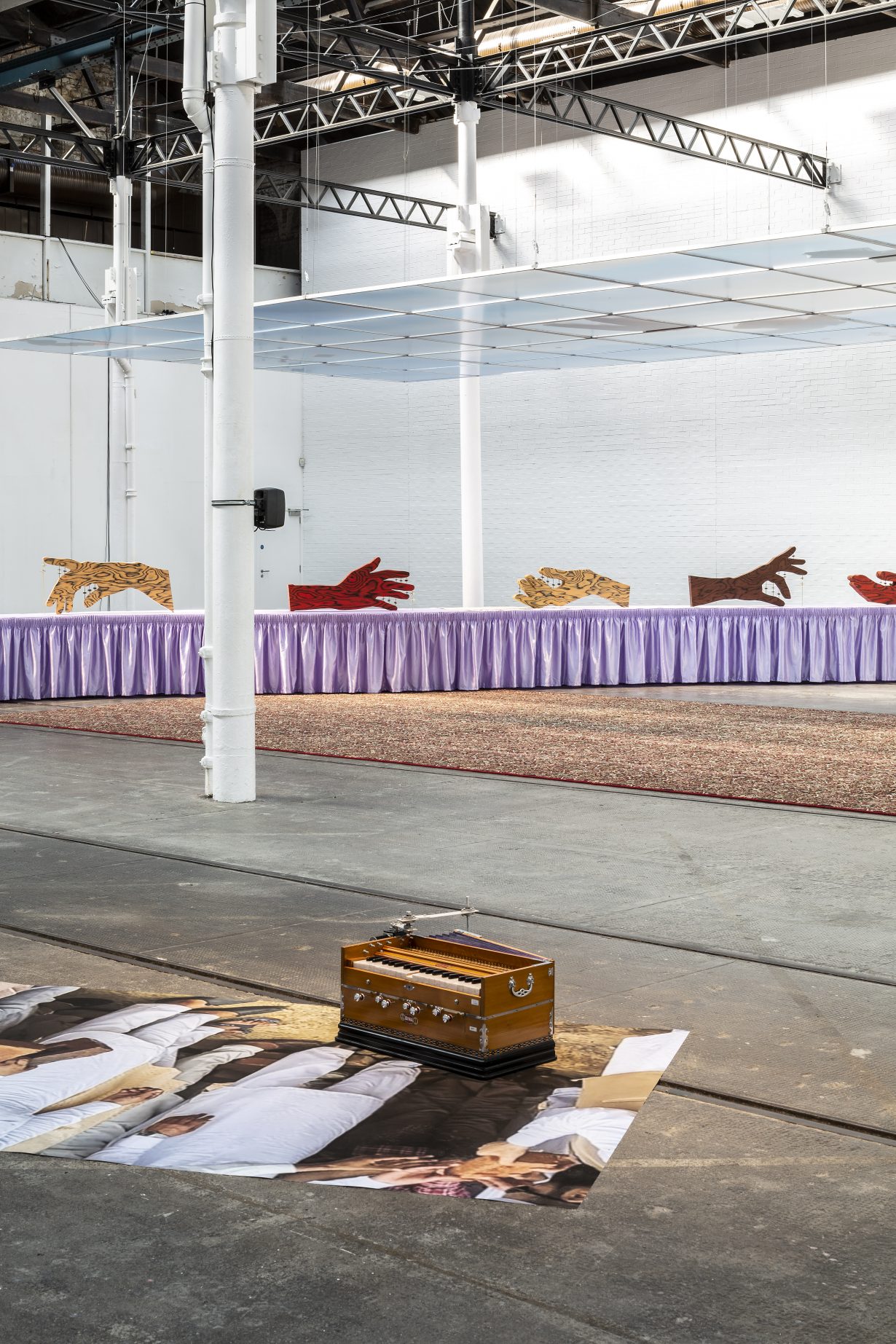The intergenerational lines of migration are traced by the Scottish Indian artist in an exhibition that both celebrates and commemorates these shared histories
Sound is mechanised as a sculptural chorus in Jasleen Kaur’s latest exhibition. A car plays intermittent snippets of songs, with an effect that’s much like the stereo of a passing vehicle, windows down on a hot summer’s day. Indian worship bells tinkle in sequences. A harmonium exhales a minor chord, rhythmically scoring the show. And adding consonance and dissonance to these soundtracks is Kaur’s own disembodied voice, chanting and singing in layered concert to fill the vast space. She addresses us directly, instructing visitors as to what image to hold in their minds: “You might visualise the vibrations of the chorus you carry”; “Imagine the expansive space, smell, sounds, chorus, the bodies besides yours. Now imagine the inside of your body, the structure, the foundations, the bones, the sinew, the flesh. What is holding you together.”
What holds this show together is a sense of the community as polyvocal. Kaur’s sculpture, photography, sound and writing are threaded throughout with the sense of a lineage – of families and peoples, tied together across continents. She selects everyday objects and materials as cultural witnesses to interwoven communities in Britain, and specifically to Glasgow’s Pollokshields, near Tramway, where she grew up. Some, like old family photographs, have been encased, immovable, in resin tinted the colour of Irn-Bru. The faces other than the artist’s have been obscured by rotis, homemade by Kaur’s mother, torn-up and now also trapped inside their orange casings. The car – a red Ford Escort – is a replica of a kind of family status symbol, in Kaur’s words a ‘representation of my dad’s migrant desires’. Pimped up with the guttural bass of a subwoofer installed by her brother, and noted in the accompanying text as one of the few places that the family would listen to music together, the car and its genre-straddling tracklist – Bob Marley, N-Trance, Punjabi MC-remixed folksongs, Nusrat Fateh Ali Khan – attest to a tender tension between generations, a symbol of literal and figurative mobility.
Other objects, like the four-metre crocheted lace that covers the car, offer material evidence of colonialism: crochet is said to have been brought to India by Scottish missionaries in the early twentieth century. The harmonium, also introduced by Western traders and missionaries in the nineteenth century as a portable alternative to the church organ, has largely replaced traditional string instruments in Sikh devotional singing, and marks a division within Sikh-Muslim Rababi musical lineages – previously linked. Kaur’s harmonium, placed next to a photograph of a mosque-rebuilding ceremony in Punjab, haunts the gallery with a sighing undertone that invites visitors to consider what is lost and what is added in the passing-down of not only objects, but also tradition.

Perspex panels suspended parallel to the ceiling act as a sky within the exhibition, and as a shelf atop which a set of objects have been scattered like detritus to be viewed, slightly refracted and out of focus, from a long Axminster carpet below. A custom tracksuit with the words ‘CAN’T DO IT’, bottles of ‘blessed’ Irn-Bru, Trebor soft mints, lottery tickets, a set of acrylic nails bursting out of a plastic bag, a floral tribute to ‘Vera’, all mingle in communion. Kaur’s title for this work, Begampur (2023), refers to the fifteenth-century Indian poet Ravidas’s vision of a stateless, classless, casteless society. In Begumpura, nobody is taxed, and nobody owns wealth. Ravidas – revered in Sikh scripture, and a Hindu in his lifetime, when non-Muslims were taxed under the Sultanate – dreamed of liberation from striated feudalism. A football scarf spells out ‘LOOOOONGING’, a word sung in the sound piece in this strung-out way over and over by Kaur, encircling the space like a lyric chasing its own tail. Amid the disparate ideologies present in her assembled troupe of accessories laid flat and lifeless, she seems to long for a gathering of real bodies.
Yet, despite the occasional cacophony, the overall volume is more often muted or disrupted: bells mark time and fleeting scrambles of song periodically erupt from the car. These moments feel flat and solemn, as though the spaces of silence are mourning. But what are we grieving? A blown-up photograph of the failed immigration raid in Pollokshields in 2021, when hundreds of residents surrounded a Home Office van to prevent two Sikh men being detained during Eid, seems to offer an answer. Community solidarity between real bodies, a listening-to of voices’ shared histories and a nostalgic riposte to the cultural amnesia brought with imperialism and state power that seeks to divide and alienate. Kaur provides space to dwell, to gather and to work towards Begumpura.
Alter Altar at Tramway, Glasgow, through 8 October
